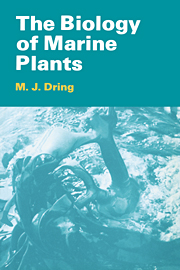Book contents
- Frontmatter
- Contents
- PREFACE
- ACKNOWLEDGEMENTS
- 1 MARINE PLANTS: TAXONOMIC, MORPHOLOGICAL AND ECOLOGICAL CATEGORIES
- 2 THE SEA AS AN ENVIRONMENT FOR PLANT GROWTH
- 3 PHOTOSYNTHESIS IN THE SEA
- 4 GROWTH AND PRODUCTIVITY OF MARINE PLANTS
- 5 MORPHOGENESIS OF MARINE PLANTS
- 6 THE ECOLOGY OF SEAWEEDS: ZONATION AND SUCCESSION
- 7 GEOGRAPHICAL DISTRIBUTION OF MARINE PLANTS
- 8 USES AND USAGE OF MARINE PLANTS
- 9 BACTERIA AND FUNGI IN THE SEA
- REFERENCES
- INDEX
2 - THE SEA AS AN ENVIRONMENT FOR PLANT GROWTH
Published online by Cambridge University Press: 02 February 2010
- Frontmatter
- Contents
- PREFACE
- ACKNOWLEDGEMENTS
- 1 MARINE PLANTS: TAXONOMIC, MORPHOLOGICAL AND ECOLOGICAL CATEGORIES
- 2 THE SEA AS AN ENVIRONMENT FOR PLANT GROWTH
- 3 PHOTOSYNTHESIS IN THE SEA
- 4 GROWTH AND PRODUCTIVITY OF MARINE PLANTS
- 5 MORPHOGENESIS OF MARINE PLANTS
- 6 THE ECOLOGY OF SEAWEEDS: ZONATION AND SUCCESSION
- 7 GEOGRAPHICAL DISTRIBUTION OF MARINE PLANTS
- 8 USES AND USAGE OF MARINE PLANTS
- 9 BACTERIA AND FUNGI IN THE SEA
- REFERENCES
- INDEX
Summary
A plant growing at sea level under clear skies will receive only about 20% less light than a plant growing at the same latitude at an altitude of 4000 m. The same percentage reduction of visible radiation occurs within about 2 m of the clearest oceanic water, and within less than 20 cm of turbid coastal water. Thus, although both air and water are commonly regarded as transparent and colourless media, light penetration through water is at least 2000-fold less than that through air. Light will, therefore, limit plant growth far more often under water than on land, and so it is necessary to examine the behaviour of light in the sea in some detail. This discussion will lead to a definition of the ‘photic zone’ — the region of the sea to which photosynthetic plant growth is necessarily restricted — and the subsequent treatment of other aspects of the marine environment can largely be limited to this surface layer of the sea.
LIGHT IN THE SEA
Measurement
Light measurement in botanical studies has been bedevilled for many years by the existence of the ‘light meter’ and a system of ‘photometric’ standards and units (lumen, lux, foot-candle, etc.). These instruments and units were specifically designed for the spectral response of the human eye, and may give very misleading results if applied in a general biological or ecological context.
- Type
- Chapter
- Information
- The Biology of Marine Plants , pp. 13 - 42Publisher: Cambridge University PressPrint publication year: 1991



